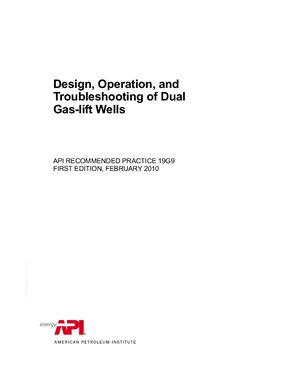122 стр.
American Petroleum Institute, First Edition, February 2010
This document provides recommended practices for the design, operation, optimization, and troubleshooting of dual gas-lift wells. Compared to single completions, dual completions have a higher initial cost, have more operating problems, are more difficult and expensive to work over, and often produce less efficiently. Based on experience, most technical gas-lift specialists and operations staff prefer single completions to duals. It is not the purpose of this document to recommend the practice of dual gas lift. In many cases, dual gas lift is problematic and often it is ineffective. Often it is difficult or even impossible to effectively produce both completions in a dual well using gas lift, over the long term. If there are other feasible alteatives to produce dual wells, they should be considered. However, many dually completed oil wells should be artificially lifted—initially or after reservoir pressures have declined and/or water cuts have increased. And in many cases, the only practical or feasible method of artificial lift for these wells is gas lift. So, if dual wells must be artificially lifted, and if the only practical or feasible means to do this is with gas lift, every effort should be made to perform this dual gas-lift function as effectively as possible. Therefore, the purpose of this document is to offer recommended practices, guidelines, and tools to make the best of what may otherwise be a difficult situation. This document also contains suggestions on practices that should be avoided to minimize problems, inefficiencies, and poor economics that may be associated with ineffective dual gas-lift operations.
American Petroleum Institute, First Edition, February 2010
This document provides recommended practices for the design, operation, optimization, and troubleshooting of dual gas-lift wells. Compared to single completions, dual completions have a higher initial cost, have more operating problems, are more difficult and expensive to work over, and often produce less efficiently. Based on experience, most technical gas-lift specialists and operations staff prefer single completions to duals. It is not the purpose of this document to recommend the practice of dual gas lift. In many cases, dual gas lift is problematic and often it is ineffective. Often it is difficult or even impossible to effectively produce both completions in a dual well using gas lift, over the long term. If there are other feasible alteatives to produce dual wells, they should be considered. However, many dually completed oil wells should be artificially lifted—initially or after reservoir pressures have declined and/or water cuts have increased. And in many cases, the only practical or feasible method of artificial lift for these wells is gas lift. So, if dual wells must be artificially lifted, and if the only practical or feasible means to do this is with gas lift, every effort should be made to perform this dual gas-lift function as effectively as possible. Therefore, the purpose of this document is to offer recommended practices, guidelines, and tools to make the best of what may otherwise be a difficult situation. This document also contains suggestions on practices that should be avoided to minimize problems, inefficiencies, and poor economics that may be associated with ineffective dual gas-lift operations.

